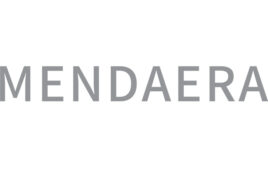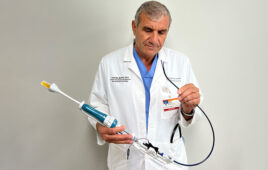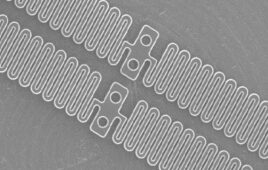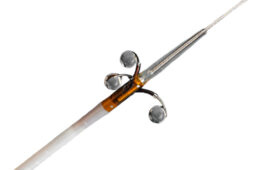
Endoscopic ultrasound-guided fine needle aspiration (EUS-FNA) has become increasingly widespread as a sampling technique for definitive pathology diagnosis.
Rich Lessig/Product Manager/EndoTherapy/Olympus Corporation of the Americas
First introduced in the early 1990s, endoscopic ultrasound-guided fine needle aspiration (EUS-FNA) has become increasingly widespread as a sampling technique for extracting tissue or cell samples from lesions for definitive pathology diagnosis. Uses for EUS-FNA include cases that require the needle to be inserted into difficult-to-access locations which only can be reached by bending the endoscope tip to a large degree. Challenging anatomy and endoscope positions can prohibit the needle from actuating smoothly and cause it to lose its shape. Maintaining needle straightness is critical to ensuring the same needle could be used to retrieve multiple samples.
A recent ASGE study showed that EUS-FNA could provide added benefit over CT scans or MRI in treating branch-duct intraductal papillary mucinous neoplasms (BD-IPMNs), lesions that can turn into cancer in the pancreas. These lesions’ position in the branch ducts makes them difficult to access, which calls for more creative ultrasound and needle solutions.
Endoscopic ultrasound (EUS) has gained ground as a valuable method for diagnosing pancreatic cancer and diseases of the GI tract. Today, the industry has moved from viewing and identifying disease to yielding better diagnostic samples and reducing cost. These developments translate into new challenges for needle design. The introduction of the Olympus EZ Shot 3 Plus EUS-FNA needle resolves the common concerns that enter into needle design.
Designers of the EZ Shot 3 Plus needle were challenged on how to:
- Obtain better samples: Flexibility was critical here, given that a high degree of curvature is present at the endoscope tip when accessing a difficult spot like the pancreatic head. To address this flexibility challenge, EZ Shot 3 Plus was constructed with nitinol, a material with great elasticity and “shape memory,” (meaning that the needle remains straight throughout the procedure). Reduced friction is also important. A multi-layer sheath construction ensures the needle travels freely and smoothly.
- Ensure the best puncturability: The needle is intended to access different anatomical structures and various lesion types. The needle tip sharpness and cutting edges were optimized for a variety of applications so, whether puncturing through tissue to reach a lymph node or puncturing the head of the pancreas, extensive simulation was necessary to reach the best design.
- Enhance visibility: Designers focused on maximizing echogenicity (how well the needle appears on ultrasound), which meant extensive research and testing into innovations in dimple design, for precisely locating the needle in a lesion or to avoid adjacent anatomic structures.
- Incorporate ergonomics: The needle handle requires a robust grip, smooth action, and visual appeal. Designers from Olympus’ consumer products group developed an aesthetic and functional handle design. Striking contrast between the dark text and white handle color make the needle identity apparent to the user. With the advent of EUS, needle design has become more challenging and demanding. One thing is certain, when it comes to sampling from a tight spot, the value of good design can’t be understated.




